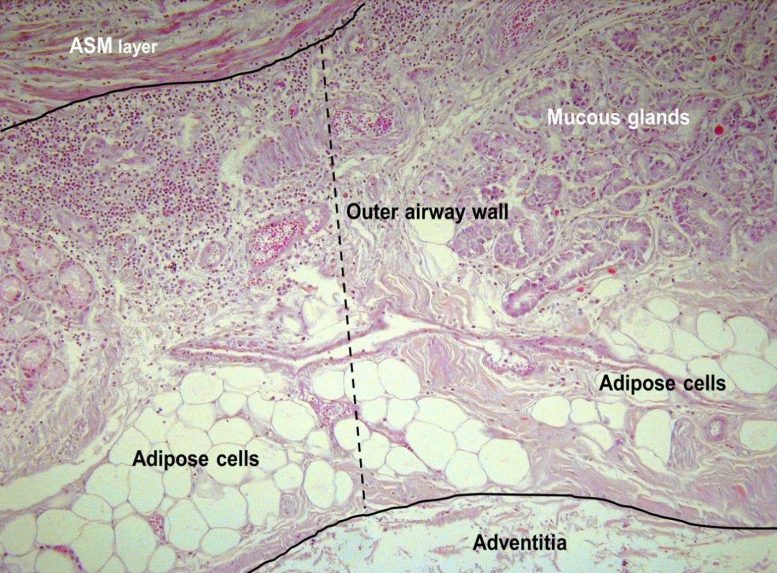
Researchers have shown for the first time that fatty tissue accumulates in the airway walls, particularly in people who are overweight or obese.
Scientists already know that people who are overweight or obese are more likely to suffer from wheezing and asthma, but the reasons for this have not been completely explained.
The new study, published in the European Respiratory Journal on October 17, 2019, suggests that this fatty tissue alters the structure of people’s airways and this could be one reason behind the increased risk of asthma.
The study’s author is Mr. John Elliot, a senior research officer at Sir Charles Gairdner Hospital in Perth, Western Australia. He said: “Our research team studies the structure of the airways within our lungs and how these are altered in people with respiratory disease.
“Looking at samples of lung, we spotted fatty tissue that had built up in the airway walls. We wanted to see if this accumulation was correlated with body weight.”
The researchers examined post-mortem samples of lungs that had been donated for research and stored in the Airway Tissue Biobank. They studied samples from 52 people, including 15 who had no reported asthma, 21 who had asthma but died of other causes, and 16 who died of asthma.

Using dyes to help visualize the structures of 1373 airways under a microscope, they identified and quantified any fatty tissue present. They compared this data with each person’s body mass index (BMI).
For the first time, the study showed that fatty tissue accumulates in the walls of the airways. The analysis revealed that the amount of fat present increases in line with increasing BMI. The research also suggests that this increase in fat alters the normal structure of the airways and leads to inflammation in the lungs.
Co-author, Dr. Peter Noble, an associate professor at the University of Western Australia in Perth said: “Being overweight or obese has already been linked to having asthma or having worse asthma symptoms. Researchers have suggested that the link might be explained by the direct pressure of excess weight on the lungs or by a general increase in inflammation created by excess weight.
“This study suggests that another mechanism is also at play. We’ve found that excess fat accumulates in the airway walls where it takes up space and seems to increase inflammation within the lungs. We think this is causing a thickening of the airways that limits the flow of air in and out of the lungs, and that could at least partly explain an increase in asthma symptoms.”
The team is looking for new ways to study and measure fatty tissue in the lungs. They want to confirm the relationship with respiratory disease and to find out whether the effect can be reversed by weight loss therapy.
Professor Thierry Troosters is President of the European Respiratory Society and was not involved in the study. He said: “This is an important finding on the relationship between body weight and respiratory disease because it shows how being overweight or obese might be making symptoms worse for people with asthma. This goes beyond the simple observation that patients with obesity need to breathe more with activity and exercise hence adding to their ventilatory burden. The observation points to true airway changes that are associated with obesity.
“We need to investigate this finding in more detail and particularly whether this phenomenon can be reversed with weight loss. In the meantime, we should support asthma patients to help them achieve or maintain a healthy weight.”
Reference: “Fatty Airways: Implications for Obstructive Disease” by John G. Elliot, Graham M. Donovan, Kimberley C.W. Wang, Francis H.Y. Green, Alan L. James and Peter B. Noble, 17 October 2019, European Respiratory Journal.
DOI: 10.1183/13993003.00857-2019
Never miss a breakthrough: Join the SciTechDaily newsletter.